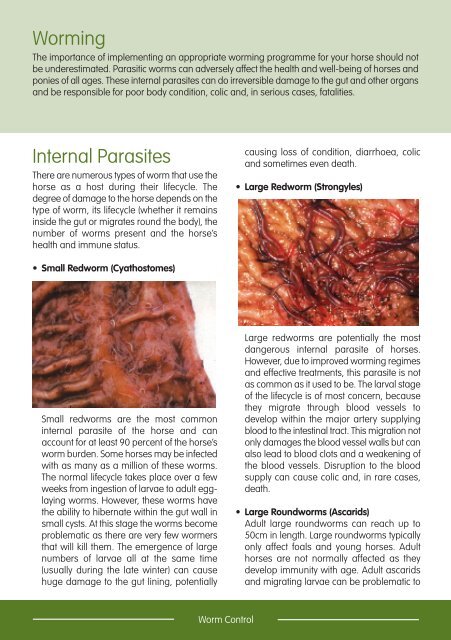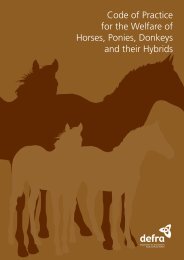Leaflet - Worm Control and Worming - British Horse Society
Leaflet - Worm Control and Worming - British Horse Society
Leaflet - Worm Control and Worming - British Horse Society
You also want an ePaper? Increase the reach of your titles
YUMPU automatically turns print PDFs into web optimized ePapers that Google loves.
<strong>Worm</strong>ing<br />
The importance of implementing an appropriate worming programme for your horse should not<br />
be underestimated. Parasitic worms can adversely affect the health <strong>and</strong> well-being of horses <strong>and</strong><br />
ponies of all ages. These internal parasites can do irreversible damage to the gut <strong>and</strong> other organs<br />
<strong>and</strong> be responsible for poor body condition, colic <strong>and</strong>, in serious cases, fatalities.<br />
Internal Parasites<br />
There are numerous types of worm that use the<br />
horse as a host during their lifecycle. The<br />
degree of damage to the horse depends on the<br />
type of worm, its lifecycle (whether it remains<br />
inside the gut or migrates round the body), the<br />
number of worms present <strong>and</strong> the horse’s<br />
health <strong>and</strong> immune status.<br />
causing loss of condition, diarrhoea, colic<br />
<strong>and</strong> sometimes even death.<br />
• Large Redworm (Strongyles)<br />
• Small Redworm (Cyathostomes)<br />
Small redworms are the most common<br />
internal parasite of the horse <strong>and</strong> can<br />
account for at least 90 percent of the horse’s<br />
worm burden. Some horses may be infected<br />
with as many as a million of these worms.<br />
The normal lifecycle takes place over a few<br />
weeks from ingestion of larvae to adult egglaying<br />
worms. However, these worms have<br />
the ability to hibernate within the gut wall in<br />
small cysts. At this stage the worms become<br />
problematic as there are very few wormers<br />
that will kill them. The emergence of large<br />
numbers of larvae all at the same time<br />
(usually during the late winter) can cause<br />
huge damage to the gut lining, potentially<br />
Large redworms are potentially the most<br />
dangerous internal parasite of horses.<br />
However, due to improved worming regimes<br />
<strong>and</strong> effective treatments, this parasite is not<br />
as common as it used to be. The larval stage<br />
of the lifecycle is of most concern, because<br />
they migrate through blood vessels to<br />
develop within the major artery supplying<br />
blood to the intestinal tract. This migration not<br />
only damages the blood vessel walls but can<br />
also lead to blood clots <strong>and</strong> a weakening of<br />
the blood vessels. Disruption to the blood<br />
supply can cause colic <strong>and</strong>, in rare cases,<br />
death.<br />
• Large Roundworms (Ascarids)<br />
Adult large roundworms can reach up to<br />
50cm in length. Large roundworms typically<br />
only affect foals <strong>and</strong> young horses. Adult<br />
horses are not normally affected as they<br />
develop immunity with age. Adult ascarids<br />
<strong>and</strong> migrating larvae can be problematic to<br />
<strong>Worm</strong> <strong>Control</strong>




